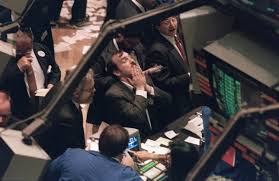This Nobel-Winning Economist Says a Black Monday Crash Can Happen Again

Thirty years ago today, on the day now known as Black Monday, the Dow Jones Industrial Average plunged 23%. Since 1987, academics, politicians, and investors have pointed their fingers just about everywhere in search of a cause, including Congress, then-President Ronald Reagan, tight monetary policy, and the stock market’s already lofty valuations.
Since Black Monday, various regulations and technologies have been put into place in hopes of preventing a similar crash — most notably “circuit breakers,” which pause trading after dramatic dips in a stock market. The New York Stock Exchange (NYSE), for example, halts trading after a drop of 7% or 13%. It halts trading for the day after a drop of 20%.
But, as Nobel Laureate Robert Shiller argues, 20% is still a big loss. It’s also a drop-off that Shiller believes is still possible today, despite the market’s recent hot streak. That’s because what Shiller believes was a fundamental cause of the crash hasn’t changed much since Black Monday: human psychology.
“That kind of panic can certainly happen again,” wrote Shiller in a New York Times op-ed about Black Monday published Thursday.
Shiller, now a professor of economics at Yale University, argues that the main causes behind the crash in 1987 were psychological in nature. When studying Black Monday, Shiller found that the selloff was largely exacerbated by investors reacting to other investors, leading to further selloffs in a self-perpetuating downward cycle.
“It became a day of fast reactions amid a mood of extreme crisis in which it seemed that no one knew what was going on and that you had to trust your own gut feelings,” Shiller wrote. And that psychological feedback loop, he argues, still exists. Just look at Los Angeles International Airport in 2016, he said, pointing to an incident in which false reports of gunshots triggered panic and hundreds of flight delays.
But today’s investors can take a bit of solace in the fact that some differences indeed exist between now and 1987 that lower the chances of such a crash. Valuations were high then and are high now, certainly. But unlike in 1987, stocks have at least one factor in their favor: low interest rates. When interest rates are high as they were in 1987, when the federal fund rate was at about 7.29%, it’s more expensive to borrow money, diminishing spending and corporate profits. Today, however, the interest rate rests at about 1.15%, making it cheaper to borrow. That in turn should translate into increased spending and profits—a trend that makes today’s stock market valuations appear more reasonable.
